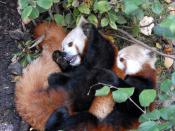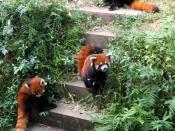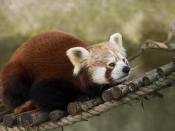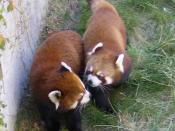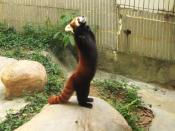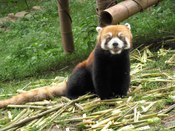RED PANDAScientific NameAilurus fulgensCommon NamesRed PandaLesser PandaFirefoxFire CatGeneral DescriptionRed pandas are skilled acrobatic mammals that live predominantly in trees5. They are crepuscular (most active at dawn and dusk), being sedentary during the day while resting in tree hollows and the branches of trees and increasing activity in the late afternoon and/or early evening hours5. As they are very heat sensitive, Red Pandas sleep during the day in shady treetop crowns, lying stretched on forked branches or rolled up in tree caves with their tail covering their face3. They are covered in rusty, reddish-brown, long, and coarse fur on upper parts and blackish fur on lower parts with a soft, dense, and woolly undercoat3. Similar in appearance to a raccoon with a face that is rounded and predominately white with reddish-brown ÃÂtear marksÃÂ running from the corner of each eye to the mouth, red pandas have bushy inconspicuously ringed tails and erect, pointed ears with white tips.
The feet have hairy soles and the claws are semi-retractable3. They waddle when walking because their front legs are angled inwards3. Similar to the Giant Panda, they have an extra pseudo-thumb on each forepaw (6th-digit)3. Red pandas mostly consume bamboo leaves, but unlike the Giant Panda they can also have fruits, acorns, roots, eggs, sprouts, grasses, insects, young birds, and small rodents3. Still they are considered herbivores even though their digestive system is designed for eating meat and because of the fact that they mainly consume bamboo. There is no outward difference between males and females1. Red pandas typically grow to the size of a house cat5 with a head and body length of 51.0 -63.5 cm, a tail length of 28.0 - 48.5cm, and a weight of 3.0 - 4.5kg3.
HabitatRed pandas are found in temperate mountain forests and bamboo thickets distributed in Nepal, Sikkim, Bhutan, Northern Burma, and the provinces of Yunnan and Sichuan in South Central China3 at elevations of 1 800-4 000 m .
AdaptationsThe colour of red pandas enables camouflage with reddish moss and white lichen in fir trees3. Red pandasÃÂ thick fur on the soles of their paws hides scent glands and serves as thermal insulation on snow or ice5. Their ringed tails are used for balance: carried straight when on a tree and horizontally on the ground. ItÃÂs even used as a cover or pillow when sleeping, especially at chilly mountain heights. The tail benefits them when they sleep during the day, shielding their eyes against the daylight. Red pandas tend to sleep curled up (like a cat or dog), with their tail over their head or sitting on top of a limb with the head tucked under the chest and between the forelegs3. When it comes to climbing, they are very agile and are able to jump 5 feet from branch to branch and descend headfirst down a tree3. The night search for food involves running with speed and agility along the ground or through trees. They place food into their mouths with their front paws and drink by plunging their paw into the water and licking it2. Red pandas are specialized feeders; they have come to develop an extra thumb to grip stalks.
Reproduction and DevelopmentMating season is in January or February when the females are in heat for 1-3 days3. After courtship and mating the male does not have anything else to do with the female or the young3. The gestation period ranges from 90 to 145 days3. Several days before birth the mother uses sticks and leaves to build a nest in an enclosed structure like a hollow tree trunk1, and gives birth to litters of 1 to 4 cubs, usually 1 or 2 cubs3. The cubs are blind and covered with fur for 21 to 30 days, making them dependent upon the mother3. They obtain adult growth at about 12 months, and reach sexual maturity at 18 months3. The live span of red pandas is about 10-12 years in captive and about 7 years in the wild3.
ClassificationThe taxonomic classification of both the red panda and the giant panda has been under debate for decades, as both species share the characteristics of bears and raccoons5. It has been classified as a relative of the giant panda, but also the raccoon4. Based off recent molecular-systematic DNA research, the red pandas has been placed into its own independent family Ailuridae5, a superfamily that includes skunks (mephitidae), raccoons (procyonidae), and weasels (mustelidae)5. It is not like a bear and unlike the giant panda in DNA5.
Importance to the EcosystemRed pandas are ambassadors for clean air and water for approximately 1 billion people on Earth as they live in the lungs (forests) of the South Asia2. Red pandas become an indication of properly functioning and intact forests for the people, animals, and plants of South Asia. They are also found in South AsiaÃÂs three largest rivers, the Brahmaputra, Ganges, and Yangtse, which provide water for half of China, Northern and North-Western India, Nepal, Tibet Autonomous Region of China, Bhutan, and Myanmar2. Again, red pandas indicate the overall health of their home, their exact population status of this demonstrates the future of one of the most important ecological regions on Earth2. Since the red pandas have unique biology in behaviour and are specialized in its habitat requirements, they also have no close living relatives2. Protecting this specie is important to preserve the worldÃÂs natural heritage and global diversity.
StatusCurrently, the red panda is endangered. Its population was low from the start as the solitariness also makes them a distributed specie. Red pandas have suffered from habitat fragmentation as there are expanding human populations, deforestation for agriculture and development4, competition with local livestock for goods, and pollution3. Deforestation destroys red pandaÃÂs nesting sites and bamboo. They are even shot illegally for game for their pelts. In addition, their predators are snow leopards (Uncia Uncia), martens (Mustelidae), and humans5.
Works Cited1. Bergner, Christina . "Red Pandas!!!!!." ARKive. 8 Mar 1997. Yahoo Hosting . 18 May 2009 .
2. Chang, Paula . "Why save Red Panda?." Red Panda Network - Conservation in Action. 2008. Red Panda Network. 16 May 2009 .
3. "EURASIA; Red Panda." torontoZOO. Association of Zoos and Aquariums. 15 May 2009 .
4. "Red Panda." National Geographic . 1996-2009. National Geographic Society. Web.17 May 2009. .
5. "Red Panda." Wikipedia. Web.16 May 2009. .
6. "Red Panda (Ailurus fulgens)." ARKive. Wildscreen. 18 May 2009 .
